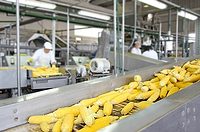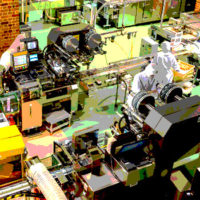Sanitary Design Considerations in Choosing a Fluid Heater

Fluid heaters are widely used in the food processing industry for heating water and other fluids, primarily for sanitization and cleaning purposes. Because the final product being produced is intended for human consumption, great care must be taken to ensure that the fluid being heated does not harbor any pathogens or microorganisms that could cause illness.
There are several important design considerations when engineering a fluid heater for use in food processing. The first and most important goal is to eliminate possible locations in the heater where contamination could occur and pathogens could grow. The second objective is to engineer a heater that is designed for efficient clean-in-place (CIP) operations when the heater is being used in production.
Preventing contamination in the fluid heater boils down to two simple goals. First, the path of the fluid through the heater must be engineered to eliminate possible locations where contaminants could accumulate. Threaded connections between wetted parts of the heater, for example, provide ideal locations for possible contamination and pathogen growth. Using non-threaded fittings, then—such as a tri-clamp design—eliminate these sources for potential contamination. Many of the heaters available on the market claim that they use sanitary connections, but most still utilize a threaded or flanged connection from the heater element to the housing. This approach does not result in a true sanitary design. Instead, tri-clamps need to be used for all connection points in the heater. This is important because any location in the heater that comes into contact with the process fluid is a potential contamination point if not properly designed.
Another possible location for contaminants to accumulate is in “dead legs” in the fluid flow path. Dead legs are bends in the process piping where stagnant water can be found. The fluid flow path through the heater, then, should be as straight as possible. Water stagnation can lead to bacteria growth and inadequate sanitary conditions.
Finally, the surface finish of the fluid heater’s wetted parts must be taken into consideration. The ideal fluid heater used in food processing applications should have as smooth a finish as possible. Rough surface finishes can provide locations for contaminants to hide and hamper the efficiency of the heater’s operation as well. Electropolished and passivated 316L stainless steel is an ideal material for use in both food processing and biopharmaceutical manufacturing applications, as it has an extraordinarily smooth surface that is nearly impervious to corrosion.
Most food processing equipment requires regular cleaning, and so engineering a sanitary fluid heater for CIP efficiency is the second major goal. The heater should be designed for complete system drainability, so that all cleaning fluids can be completely purged from the heater following CIP operations. An efficient means of accomplishing this is to put the heater input on the bottom of the heater, allowing for gravity draining after the CIP process is complete.

The final consideration in designing a sanitary heater for food processing applications is fluid temperature control. In order to get consistent results, maintaining a precisely-regulated fluid temperature is important in both food processing operations and CIP cycles as well. The sanitary fluid heater engineered by Heateflex uses an electrically-heated coil inside the heater housing to ensure a consistently-regulated heat output. In contrast, many of the fluid heaters used in food processing applications are steam-powered. Fluid temperatures in steam-powered heaters can fluctuate more than those in electrically-powered heaters, leading to inconsistent process results.
In summary, consider both contamination control and operational efficiency when designing a sanitary fluid heater for use in food processing applications. The Heateflex sanitary design fluid heater, shown in Figure 1, was engineered with these objectives in mind. The patented sanitary design allows Heateflex to offer a true sanitary design, with zero threaded fittings, zero “dead legs” in the fluid path, and complete system drain-ability to prevent particle entrapment and possible microbial growth. The heater is available in multiple voltages, and in outputs ranging from 12 kW to 24 kW.
JP Rivera is Heateflex Corporation's director of U.S. sales.With over 12 years of sales experience, JP manages the Heateflex sales and marketing teams. Under his guidance, the team works to provide Heateflex customers with exceptional service and support. JP’s knowledge of the company’s products and customer requirements help to provide Heateflex customers with a precise solution to meet their strategic requirements. He holds a bachelor’s degree in marketing from California Polytechnic University, Pomona.
Looking for a reprint of this article?
From high-res PDFs to custom plaques, order your copy today!





